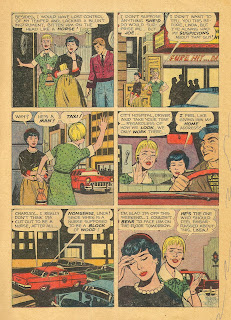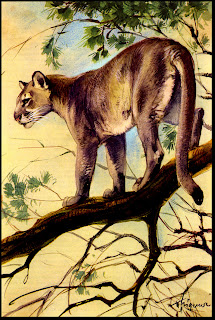Many of these had great artwork!
28 February 2013
27 February 2013
The Gods Hate Kansas
Great title for this 1941 science fiction novel.It was one of the first novels of "aliens taking over humans by mind control".
It was made into a movie in 1967 called They Came from Beyond Space
A later magazine reprint:
It was made into a movie in 1967 called They Came from Beyond Space
 |
| first published in the pulps in 1941 |
 |
| paperback edition 1964, cover painting by Jack Thurston |
A later magazine reprint:
26 February 2013
Mr. Bass's Planetoid
Mr. Bass's Planetoid is a 1958 children's science fiction novel by Canadian author Eleanor Cameron. The novel followed The Wonderful Flight to the Mushroom Planet (1954) and Stowaway to the Mushroom Planet (1956).
I loved these books as a child. The notion that 2 boys could build a spaceship out of tin cans and travel to outer space was very appealing!
The Illustrations are by Louis Darling.
I loved these books as a child. The notion that 2 boys could build a spaceship out of tin cans and travel to outer space was very appealing!
The Illustrations are by Louis Darling.
Prewytt Brumblydge, inventor of the Brumblitron, must be found in order to disable the device before it destroys the Earth. This is a job for Mr. Bass, but he has disappeared... so the boys pore over his notebook for clues and go spacefaring to find Brumblydge. This time, instead of journeying to Basidium, they fly to an airless rock named Lepton that orbits 1,000 miles above the Earth's surface.
This novel also introduced the fictional metal Brumblium, a greenish metal, that shows as infragreen on a spectroscope, and is twice the density of uranium.
25 February 2013
Comic Book Short Story~Nurse Linda Lark
This story, probably drawn by John Tartaglione, is from "Linda Lark Registered Nurse" #2, Jan. 1962. Issues #1 was titled Linda Lark Student Nurse"
24 February 2013
23 February 2013
22 February 2013
The Wonderful Flight to the Mushroom Planet
The Wonderful Flight to the Mushroom Planet is a science fiction/fantasy children's novel written by Eleanor Cameron in 1954. It is set in a beach community in California, as well as on a tiny, habitable moon, "Basidium," in an invisible orbit 50,000 miles from Earth. The "Mushroom Planet," visited by the protagonists David and Chuck, is covered in various types of mushrooms and is populated by little green people who are in a state of distress.
When two boys find a mysterious ad in a newspaper asking for two young boys to build a spaceship, they quickly construct one out of old tin and scrap wood, and bring it to the advertiser. This man is the mysterious Mr. Bass, a scientist living in an observatory who goes unnoticed by most of the townspeople for some reason. He shows the boys a previously undetected satellite of the Earth, the eponymous planet, which can only be seen with a special filter he has invented. He refits their spaceship, giving them some special fuel he invented to power it, and tells them to fly to the mushroom planet (after getting their parents' permission). He warns them that their trip will only be successful if they bring a mascot.
When it is time for launch, they grab a hen at the last moment for a mascot, and rocket into space. They wake up on the mushroom planet, a small, verdant world covered in soft moss and tree-size mushrooms. They quickly meet some residents of the mushroom planet, small men with large heads and slightly green skin, of the same people as the mysterious Mr. Bass. They tell the boys that their planet has had a crisis and that everyone is slowly dying of a mysterious sickness. The boys meet up with the king of the planet, the Great Ta, and end up solving the natives' problem, before returning to Earth.
21 February 2013
20 February 2013
19 February 2013
Wildlife by Wilhelm Eigener
Wilhelm Eigener (1904-1982) was a German animal illustrator and graphic artist.
He worked from 1930 to 1938 as chief draftsman at Friedlander , a Hamburg printing company ,where he specialized on circus posters. During the 2nd World War II he served as a soldier in Poland and Russia. From the 1950s, he was one of the most sought after animal and nature's book illustrators. His realistic watercolors are in many books on biology but also on the covers of publications of Berlin Zoo. These are from 1961.
 |
| click a time or two for HIGH RES |
He worked from 1930 to 1938 as chief draftsman at Friedlander , a Hamburg printing company ,where he specialized on circus posters. During the 2nd World War II he served as a soldier in Poland and Russia. From the 1950s, he was one of the most sought after animal and nature's book illustrators. His realistic watercolors are in many books on biology but also on the covers of publications of Berlin Zoo. These are from 1961.
18 February 2013
17 February 2013
16 February 2013
Subscribe to:
Posts (Atom)
























































